Our History (1866-1939)
A Note on Language
When you research the history of Fairfax County Public Schools (FCPS) during the period of 1870 to 1970, you will invariably encounter racially-charged language that is archaic and often problematic by modern standards. In particular, the primary source documents from the period use the terms “colored” and “Negro” to commonly describe students and schools. In the following text, the word colored is being used in its historically correct context.
The Freedmen’s School
Louise Archer Elementary School can trace its roots to the first public school for African-American children in Vienna. As the American Civil War drew to a close, on March 3, 1865, the Federal Government established the Bureau of Refugees, Freedmen, and Abandoned Lands to assist newly freed slaves. The Freedmen’s Bureau, as it was more commonly known, issued food and clothing, provided healthcare and temporary housing, and established schools. In Fairfax County, the Freedmen’s Bureau supplied funding and materials to build several schools for African-American children. Historian Debbie Robison, author of “Educating Freedmen During Reconstruction in Fairfax County,” is the foremost expert in the Freedmen’s Schools of Fairfax County. She wrote:
From 1864 to 1868, fifteen schools were established in Fairfax County for freedmen that were supported, in one way or another, by the Freedmen’s Bureau. Although the location of the first school at Vienna, which opened in March 1866, is unknown, repairs to the school house were underway later that year [according to Freedmen’s Bureau records]. On September 18, 1866, Capt. J. A. Ross wrote to S. P. Lee to learn the disposition of supplies he requested for repairing school houses. Ross noted that a school teacher was there in Vienna waiting for her school to be completed. The teacher, Mary K. Brosius, wrote that the school house was so small that she almost had to stack the pupils since she didn’t have the heart to turn anyone away. She hoped to have a larger school house in March or April of 1867.
Major O. E. Hine, a native New Yorker and former Union Army officer, was the Freedmen’s Bureau agent for Fairfax County. On September 1, 1867, Major Hine and his wife Alma sold one-eighth acre of land in the village of Vienna to Daniel West, George M. Brown, and Edmond Harris, Trustees of the Colored School at Vienna, with the stipulation that the property be used for school or church purposes. The trustees constructed the First Baptist Church of Vienna on the site, and the building also served as the village’s school for African-American children into the 1890s.

The Public Free Schools of Virginia
Fairfax County Public Schools (FCPS) was founded in 1870 with the passage of the Public Free Schools Act and the ratification of the new Virginia constitution. The Public Free Schools law required school districts to operate separate schools for white and African-American children. FCPS operated as one school system, but had six separate school boards, one for each magisterial district. In 1870, the Freedmen’s School in Vienna was folded into Fairfax County’s public school system, and came under the management of the School Trustees of Providence District. In 1890, when the Town of Vienna incorporated, the town formed its own School Board. According to historians Connie Stuntz and Mayo Stuntz, the improvement of the schools in Vienna was one of the prime motivators for the incorporation of the town [Stuntz, Page 192]. A bond issue for $500 to fund the construction of a new school for African-American children was approved, and, in October 1896, Thomas Frey and his wife Sarah sold half-an-acre of land at the intersection of Malcolm Road and Lawyers Road to the School Trustees of Vienna District for $75. A one-room schoolhouse was constructed on the lot. There was no well on the property, so older boys carried drinking water to the school in a bucket they filled each day at a spring on the property of Captain Harmon L. Salsbury. The Salsbury Spring can be seen today at the intersection of Lawyers Road and Windover Avenue.

Growing Up in Vienna
In January 1970, William A. West, who was age 95 at the time, was interviewed in conjunction with the Centennial Commemoration of Fairfax County Public Schools. Mr. West was born in Vienna and attended public school at the Vienna Colored School. He later became a teacher with FCPS and taught at the Cartersville School, the Odrick’s Corner School, and the Vienna Colored School. In this audio excerpt from the interview, Mr. West shares some of his memories of the Vienna Colored School.
William A. West Interview Transcript
WEST: My father settled in Vienna in 1867, and he worked for a while for Major O. E. Hine.
QUESTION: When were you born Mr. West?
WEST: March the fourth 18 and 74. My dad opened up the school for the colored in the old church. In fact, the school - Major Hine had given them the piece of land.
QUESTION: Was that one of the first schools for Negro children in this area?
WEST: I imagine it was the first school in Fairfax County, first school for Negroes. Now the schools then we're numbered alpha-numerically. This school was Number A, don’t you see? This Colored school here is Number A, and we held it in the church until after Vienna was incorporated. After Vienna was incorporated then they decided that they would issue a bond issue. You see at that time the schools operated different to what they do now. We had each district had its own school board. And Vienna, when Vienna was incorporated, why it had its own school board don’t you see? So they floated a bond issue here in Vienna for $1,500 and they built the white school with $1,000 and built the Colored school for $500.
QUESTION: Mr. West can you tell us what your first school days were like? What's the very first remembrance you have of school?
WEST: Oh I first remember that the school was – that it was a large room and it had some long homemade benches in it. And they had some plain boards fastened to the back of those benches for desks, so forth. And the furniture other furniture consisted of one chair and one desk for the teacher. They had a map on the wall. On one side was the American continent and the other side was Europe, Asia, Africa and so forth. Well I continued in that school until I finished. I was 15 years old.
QUESTION: What were some of the subjects that you studied in the one-room school and who was your teacher?
WEST: In the one-room school we would have reading, writing, arithmetic, geography, history, and usually physiology and so forth. We had to buy our own books, don't you see? We had to buy books – the reading, geography, arithmetic, and all those – we had to buy those ourselves.
QUESTION: How many children did go to school in this community?
WEST: Evidently there were anywhere from 60 to 80 children.
QUESTION: All in one room?
WEST: All in one room, yes ma’am, all in one room.
QUESTION: One teacher?
WEST: One teacher.
QUESTION: How did she maintain discipline?
WEST: Oh that was - just the best they could.
Like Mr. West, Gloria Carter, Alees Coates, and Burnadine Harris grew up in Vienna. They attended the Vienna Colored School at its Nutley Street location in the 1940s. At that time, Vienna was still very rural, and many aspects of daily life were similar to what Mr. West experienced in his childhood. When they were interviewed in 2020, these women described what it was like growing up in Vienna.
The Odd Fellows Hall
In 1918, the Town of Vienna abolished the Vienna School District and transferred its school properties to the School Trustees of Providence District. Around this same time, the Vienna Colored School had become overcrowded, and students in the upper grades attended class at the Odd Fellows Hall located on the opposite side of Lawyers Road from the school. The trustees of the Odd Fellows Hall entered into a very generous arrangement with the School Trustees, charging just $28 for rent of the building for the entire school year. In the summer of 1922, the magisterial and town school boards were abolished, and the consolidated Fairfax County School Board was formed. The newly formed School Board continued to rent the Odd Fellows Hall, paying William A. West, one of the Hall’s trustees, $28 in rent in January 1923.

During the winter of 1919-20, the Vienna School for white children was destroyed when the boiler used to heat the building exploded. The accident happened in the middle of the night, and fortunately no one was hurt, but the explosion and resulting fire reduced the school to ashes. A temporary two-room building was constructed to house the students while a new school was built. The new school, the modern Vienna Elementary School, opened in 1923. In August 1924, the School Board hired O. A. Wright to move the temporary two-room building to the Vienna Colored School lot.

It is believed that the appointment of Louise R. Archer as principal/teacher of the Vienna Colored School coincided with the expansion of the school to three rooms in the fall of 1924, however we have been unable to find a verification of this in FCPS records.
The 4-H Club
In 1935, a 4-H club was formed at the Vienna Colored School. In her book “Louise Archer: The Educator and the School,” historian Sylvia B. Taylor wrote:
The county agent wrote about this club in his annual report of 1936. He said at the outset that he “did not expect much from it,” but was quite impressed with the report Principal Archer sent him. The club’s project was raising and canning fruits and vegetables. The boys and girls raised 152 bushels of food. Thirty-one bushels were stored and 1,890 quarts of fruits, vegetables, and jellies were canned. The canned vegetables were later used in preparation of school lunches. He praised Mrs. Archer for the amount of interest she had created among the students, especially considering that they had received little or no 4-H assistance, and also since, in his opinion, many of the students had limited garden space.
A New School
Even with its expansion to three rooms, the Vienna Colored School continued to face overcrowding well into the 1930s. As early as October 1933, the Fairfax County School Board had begun planning for the construction of a new school for African-American children in Vienna. However, little action was taken by the Board to bring this school to fruition until 1938. On August 5, 1935, a large delegation of African-American residents from all over Fairfax County attended a meeting of the School Board. Ollie Tinner, representing the Committee on Education of the Fairfax County Colored Citizens Association, spoke about the desperate need for improvements to the schools for African-American children and requested that a four-room school be constructed at Vienna. In February 1937, Mrs. Bernice Ellis, Secretary of the Vienna Colored School League, wrote a letter to the School Board urging for the construction of a better school building at Vienna. Frustrated by the lack of action on the part of the School Board, the African-American residents of Vienna took action.
The Rosenwald Schools
In the early 20th century, the Rosenwald Rural School Building Program built state-of-the-art schools to advance the education of African-American children in the southern United States. The program was created by Booker T. Washington and the Tuskegee Institute, and was funded by philanthropist Julius Rosenwald, president of the Sears and Roebuck Company. From 1917 to 1932, the Rosenwald Foundation donated $4.4 million to construct approximately 5,000 schools in the rural south.

At least three schools were constructed in Fairfax County using funding donated from the Rosenwald Foundation (the Fairfax, Oak Grove, and Seminary Colored schools). Julius Rosenwald initially thought Sears & Roebuck should manufacture pre-fabricated schoolhouse kits, similar to Sears catalog homes, but Booker Washington insisted that the local community participate in the design and construction of the buildings, because doing so would foster community involvement in the school and provide a source of employment during construction. It was also decided that Foundation funding should only partially cover the cost of a new school, and that matching funds would need to be raised by the community and the local school board.

When he was interviewed in 1970, William West described the efforts of the African-American community in the 1930s to construct a new schoolhouse in Vienna. According to West, the community decided to pursue a Rosenwald Foundation grant and raised matching funds as stipulated by the foundation. However, by 1932 the Rosenwald Foundation had run out of funding for school construction projects. Undeterred, the community and Principal Louise Archer continued to impress upon the Fairfax County School Board the need for a new school, and, in April 1938, the School Board expressed its willingness to construct a school as soon as funding became available.

In addition to funding, the Rosenwald Foundation supplied plans for schoolhouses, guidance on how school sites should be chosen, and directions on which way the building should face to maximize the use of natural light. The earliest building plans were designed by architect Robert Robinson Taylor, the first African-American graduate of the Massachusetts Institute of Technology. The new Vienna Colored School, later renamed the Louise Archer School, was designed in 1938 by an architect employed by Virginia’s State Board of Education. The school architects employed by the state had access to all the Rosenwald building plans. The layout of the three-room Vienna Colored School appears very similar in design to Floor Plan Number 20, a two-room Rosenwald plan created by Samuel L. Smith, and may have been a modified version of that design.

After the construction of the new Vienna Colored School (Louise Archer Elementary School) on Nutley Street had been completed in 1939, the School Board offered the 1896 school building on Malcolm Road/Lawyers Road for sale at public auction. The auction was held on Friday, May 24, 1940, but the Board rejected all the bids on the property as being too low. A private offer of $800 was accepted and, on September 27, 1940, the building was sold to August Beuchert. The schoolhouse was later converted into a dwelling.

Sources
Robison, Debbie. Educating Freedmen During Reconstruction in Fairfax County. Robison, December 6, 2014.
Stuntz, Connie Pendleton and Mayo Sturdevant Stuntz. This Was Vienna, Virginia: Facts and Photos. C. P. Stuntz and M. S. Stuntz, 1987.
Taylor, Sylvia B. Louise Archer: The Educator and the School. Fourth Edition. Sylvia B. Taylor, 2016.
West, William A., Personal Interview, January 22, 1970. The interview was produced by Fairfax County Public Schools and currently resides in the Special Collections and Archives of George Mason University. Mr. West, who was age 95 at the time, was interviewed in conjunction with the Centennial Commemoration of Fairfax County Public Schools by George Hamel from the Office of School-Community Relations, Rita C. Apter, then principal of Vienna Elementary School, and Elliott Mary Krash, a school development intern with FCPS.

